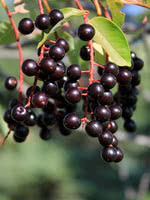Mon-Fri 9am - 5pm Mountain time
Western Chokecherry vs Korean Boxwood
Prunus virginiana var. demissa
Buxus microphylla Koreana
CUSTOM GROW
Western Chokecherry is a shrub or small tree commonly used for farmstead and field windbreaks.
It produces white flowers in the spring and edible dark purple fruit that matures between September and October. Its cherries are great for making for making jams, jellies or wine, but are not very palatable for raw eating.
Korean Boxwood is a vibrant evergreen shrub. A top choice for colder climates, this shrub will look stunning lining a driveway or as a foundation plant.
Easy to root in and maintain, Korean Boxwood's thick foliage is deer resistant and turns an attractive yellow-brown to purplish in winter. Consider applying mulch around the base to keep the roots moist and cool.
Western Chokecherry Quick Facts
Korean Boxwood Quick Facts
Toxicity: toxic to horses, cattle, etc.)

